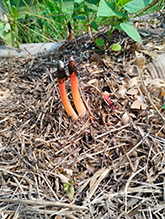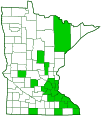Devil's Dipstick
(Mutinus elegans)
Conservation • Description • Habitat • Ecology • Distribution • Taxonomy
|
|
||||||||||||||
Description |
Devil's Dipstick is a common, brightly colored, stinkhorn fungus. It occurs in the United States east of the Great Plains and in southern Quebec and Ontario Canada. It has also been reported in Europe, Japan, and Brazil. Devil's Dipstick is found alone or in groups but not clustered (gregarious), in woodlands, agricultural areas, and gardens. It grows on the ground near well-decayed stumps, around old logs, and in wood chips. It is saprobic, obtaining its nutrients from decaying wood. Stinkhorns in the genus Mutinus are easily recognized by their unusual growth form. Unlike other stinkhorns, they do not have a spore-baring cap. The spore-bearing portion of the stalk may be sharply defined at the bottom, giving the appearance of a cap, but there is no distinct cap separate from the stem. When it first appears, the fruiting body is white, egg-shaped, ¾″ to 1⅜″ (2.0 to 3.5 cm) long, and ⅝″ to ¾″ (1.5 to 2.0 cm) wide. It is at least partially submerged in the ground. The surface is smooth, and it often has purplish or lilac shades. It resembles a puffball, and at this stage it can be mistaken for one. The outside of the “egg” is the universal veil, protecting the developing mushroom. Inside the egg there is a gelatinous layer, an olive-green to greenish-brown spore mass (gleba), and all of the fully formed parts of the mature stinkhorn. When conditions are right the egg ruptures and expands rapidly. In one or two days it produces a tapered, cylindrical stalk. The rapid expansion is possible because all of the parts are fully formed and compressed inside the egg, and because the individual cells elongate, rather than new cells being produced. As the stinkhorn expands, the gelatinous layer mixes with the spore mass producing a shiny, putrid slime that covers the upper part of the stalk. The foul-smelling slime is irresistible to flies, which feed on it, lay their eggs in it, and transfer spores when they fly to other stinkhorns. It is a smelly nuisance to homeowners who find it under their wooden deck. The mature, fresh stalk is bright orange to yellowish orange, hollow, spongy, 2⅜″ to 7″ (6 to 18 cm) high, and ⅜″ to ¾″ (1 to 2 cm) thick at its widest point. It is usually evenly, “elegantly” tapered to a point at the tip. This is the feature that gives the stinkhorn one of its other common names, elegant stinkhorn. As it ages it fades to pale orange, yellow, pinkish, or nearly white. The upper part of the stalk is covered with a thick, slimy or gluey, shiny, olive-green to olive-brown, spore-bearing mass (also called gleba). The gleba has a strong, putrid odor, repulsive to humans but irresistible to flies. The remnants of the ruptured universal veil (volva) persist at the base of the stalk. The volva is cup-like, loose, and whitish to purplish. It is usually buried underground or hidden under leaves. It is attached to thin, white, root-like structures (rhizomorphs). All stinkhorns are edible but the slimy consistency inside the “egg” and the putrid odor of the mature specimen are enough to dissuade most from collecting it for the table. |
Similar Species |
Dog Stinkhorn (Mutinus caninus) is shorter, no more than 4½″ (12 cm) high. The stalk pale, not brightly colored, either yellowish-white, yellow, or pale orange. The spore-bearing portion covers a much smaller part of the stalk. Ravenel’s Stinkhorn (Phallus ravenelii) has a distinct cap. |
Habitat and Hosts |
Woodlands, agricultural areas, and gardens |
Ecology |
Season |
Summer and fall |
Distribution |
||
|
Sources Biodiversity occurrence data published by: Minnesota Biodiversity Atlas (accessed through the Minnesota Biodiversity Atlas Portal, bellatlas.umn.edu, 7/27/2025). |
|
| 8/13/2025 | ||
Occurrence |
||
Common |
||
Taxonomy |
|
Kingdom |
Fungi (Fungi) |
Subkingdom |
Dikarya |
Phylum |
Basidiomycota (Basidiomycete Fungi) |
Subphylum |
Agaricomycotina (Higher Basidiomycetes) |
Class |
Agaricomycetes (Mushrooms, Bracket Fungi, Puffballs, and Allies) |
Subclass |
Phallomycetidae |
Order |
Phallales (stinkhorns and allies) |
Family |
Phallaceae (stinkhorns) |
Genus |
Mutinus |
Subordinate Taxa |
|
|
|
Synonyms |
|
Caromyxa elegans Caryomyxa elegans Corynites elegans |
|
Common Names |
|
Devil's Dipstick Dog Stinkhorn Elegant Stinkhorn Headless Stinkhorn |
|
Glossary
Gleba
The inner spore-bearing mass of puffballs, earthstars, and stinkhorns. The term is also used to refer to the spore-bearing slime covering the head of a stinkhorn.
Rhizomorph
A root-like, mycelial cord of a fungus, formed from vessel hyphae surrounding sheathing hyphae, and capable of transferring nutrients over long distances.
Saprobic
A term often used for saprotrophic fungi. Referring to fungi that obtain their nutrients from decayed organic matter.
Universal veil
An egg-like structure that envelopes all or most of a developing gill mushroom. Remnants of the universal veil sometimes visible on a mature mushroom are patchy warts on the cap, a ring on the stem, and a volva at the base of the stem.
Volva
Also called cup. A cup-like covering at the base of a mushroom stem, sometimes buried. In Amanita, Volvariella, and some other mushrooms, it is the remnants of the universal veil ruptured by the mushroom pushing through. In Phallales it is the remnants of the ruptured peridium.
Visitor Photos |
||
Share your photo of this fungus. |
||
This button not working for you? |
||
Ann W |
 |
Carl Behr |
 |
looks like a lobster claw. It grew after a heavy rain and died after only one day. |
MinnesotaSeasons.com Photos |
||
|
||
|
||

Slideshows |
|

Visitor Videos |
||
Share your video of this fungus. |
||
This button not working for you? |
||
|
Other Videos |
||
Alien Stinkhorn Fungus Mushroom Mutinus Elegans |
About
Sep 21, 2018 An odd alien looking fungus mushroom known as the Stinkhorn Fungus or Dog Stinkhorn Mutinus Elegans. |

Visitor Sightings |
||
Report a sighting of this fungus. |
||
This button not working for you? |
||
Ann W |
Location: Mille Lacs Co. |
 |
Carl Behr |
Location: Northfield, MN looks like a lobster claw. It grew after a heavy rain and died after only one day. |
 |
MinnesotaSeasons.com Sightings |
||
|

|
Created: 7/27/2025 Last Updated: © MinnesotaSeasons.com. All rights reserved. |
